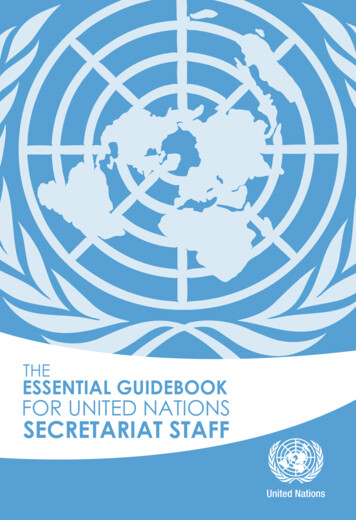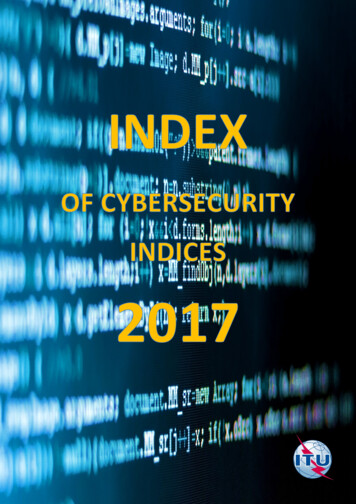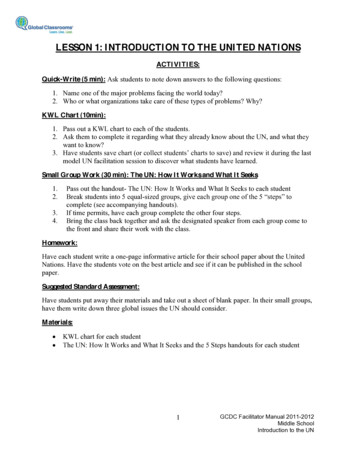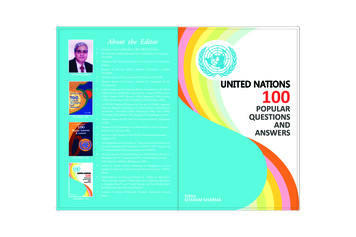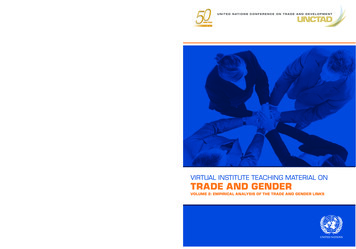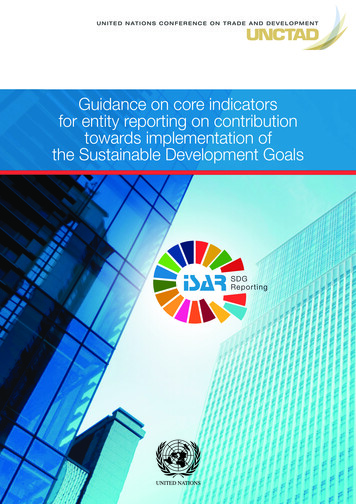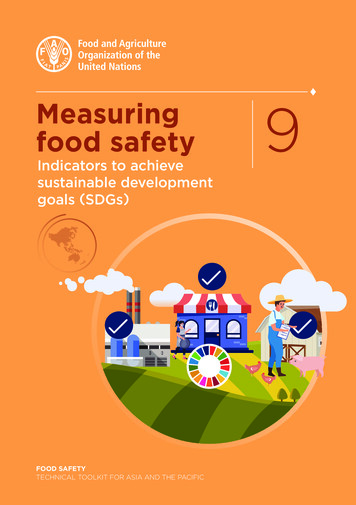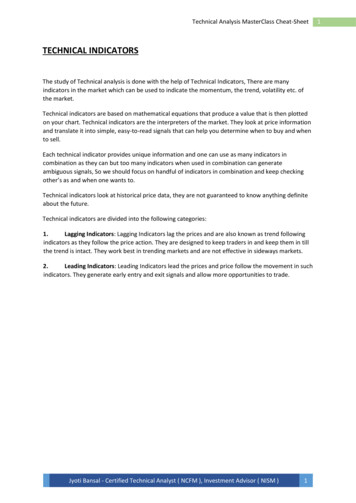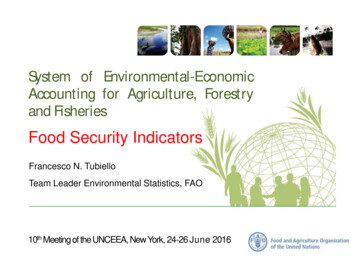
Transcription
System of Environmental-EconomicAccounting for Agriculture, Forestryand FisheriesFood Security IndicatorsFrancesco N. TubielloTeam Leader Environmental Statistics, FAO10th Meeting of the UNCEEA, New York, 24-26 June 2016
Connecting SEEA and Food security Indicators FAO development of a set of Food Security Indicators forinternal analysis Linkage to FAO Food Security Indicators for SDGs Goal 2:“End hunger, achieve food security and improvednutrition and promote sustainable agriculture” Connection of FAO Food Security Indicators directly fromSEEA-Agriculture, providing a link with SDGs
Connecting SEEA and Food security IndicatorsSEEA-AgricultureFood SecurityIndicatorsFAO StatisticsSetEnvironmental SustainabilityIndicatorsFAOSDGs Goal 2
FAO Food Security Indicators and SEEA-Agriculture Following the recommendation of experts gathered at the Committee onWorld Food Security (CFS) Round Table on hunger measurement,hosted at FAO in September 2011, a set of indicators aiming to capturethe four dimensions of food security (Availability, Access, Stability,Utilization) were developed by the FAO Statistics Division. Examples:Type of indicatorAvailabilityAverage dietary energy supplyAverage value of food productionShare of dietary energy supply derived from cereals,roots and tubersAverage protein supplyAverage supply of protein of animal 0-2011FAOFAO1990-20111990-2011
FAO Food Security Indicators and SEEA-Agriculture Following the recommendation of experts gathered at the Committee onWorld Food Security (CFS) Round Table on hunger measurement,hosted at FAO in September 2011, a set of indicators aiming to capturethe four dimensions of food security (Availability, Access, Stability,Utilization) were developed by the FAO Statistics Division. Examples:Type of indicatorSourceAccessPercent of paved roads over total roadsDomestic food price indexPrevalence of undernourishmentDepth of the food deficitPrevalence of food 00-20141990-20161990-20161990-2016
FAO Food Security Indicators and SEEA-Agriculture Critical indicators can already be derived and expanded by SEEAAgriculture, Global Combined Presentation: Average Value of Food Production (Availability) Share of dietary energy supply derived from cereals, roots andtubers (Availablity) Prevalence of Undernourishment (Access) Cereal import dependency ratio (Stability) Per capita food supply and variability (Stability)
SEEA-Agriculture Global Combined PresentationLandAssetsInputsOutputs Impacts
SEEA-Agriculture Global Combined Presentation (Assets)AssetsSEEA-AGRI COMBINED PRESENTATIONGlobal LevelLand Area(000 ha)Harvested Area(000 ha)Biomass stock (million metrictonnes)AbovegroundbiomassAgricultureArable Land and Permanent CropCrops PrimaryPermanent Meadows and PasturesLive Animals and Livestock PrimaryForestFisheriesInland waterOther LandSOURCE: FAOSTAT DatabaseLegend:Data availableData not availableBelowgroundbiomassDead woodProducingNumber of HeadsAnimals/Slaughtered(000)(000)Employment inAgriculture(1000)
SEEA-Agriculture Global Combined Presentation (Outputs and Impacts)OutputsDomestic productionProduction (000 T)000TM3ValueaddedGDPGrossProductionValue Prices in USD(current constant millionmillion US ) 2005 dollarsmillion(current)USD Environmental ImpactsExportsM3000Currency(000 T)(Head)(1000 )ImportsM3000 (Head) (000 T)Food Consumption/NutritionCurrency(1000 )Food (000 T)Kcal/percapita/perdayGHG Emission (CO2 eq) fromAgriculture(Gigagrams)
Targets and Indicators for the SDGs and SEEA:Goal 2: Food Security Indicators In its “Targets and Indicators for the Sustainable Development Goalsand the Post-2015 Development Agenda”, FAO proposed indicators tomonitor progress towards SDGs goals and targets. Examples for Goal 2 and direct linkages to SEEA-Agriculture include:Target 2.1:By 2030, end hunger and ensure access by all people, in particular the poor and people invulnerable situations, including infants, to safe, nutritious and sufficient food all year roundIndicator 2.1.1Prevalence of population with moderate or severe food insecurity, based on the FoodInsecurity Experience Scale (FIES)Indicator 2.1.2Prevalence of Undernourishment (PoU)Target 2.3:By 2030, double the agricultural productivity and incomes of small-scale food producers, inparticular women, indigenous peoples, family farmers, pastoralists and fishers, includingthrough secure and equal access to land, other productive resources and inputs, knowledge,financial services, markets and opportunities for value addition and non-farm employmentIndicator 2.3.1Value of production per labour unit (measured in constant USD), by classes offarming/pastoral/forestry enterprise size
Targets and Indicators for the SDGs and SEEA:Goal 2: Linking Food Security to Agri-environmental Indicators In its “Targets and Indicators for the Sustainable Development Goalsand the Post-2015 Development Agenda”, FAO has proposedindicators that could be considered for FAO to monitor progresstowards a subset of SDGs and related targets. Examples for Goal 2:Target 2.4:By 2030, ensure sustainable food production systems and implement resilient agriculturalpractices that increase productivity and production, that help maintain ecosystems, thatstrengthen capacity for adaptation to climate change, extreme weather, drought, floodingand other disasters and that progressively improve land and soil qualityIndicator 2.4.1Percentage of agricultural area under sustainable agricultural practicesSEEA AgricultureSoil Quality, LandCover and Land UseChange;Deforestation andForest DegradationGreenhouse gasemissions/removals,including per unitcommodityWater accounts;water stress indexes
Connecting SEEA and Food security IndicatorsSEEA-AgricultureFood SecurityIndicatorsFAO StatisticsSetEnvironmental SustainabilityIndicatorsFAOSDGs Goal 2
Conclusions Key Food Security Indicators developed by FAO, relevant tothe SDG monitoring process, can be directly derived fromSEEA-Agriculture Global Combined Presentation Others, including environmental sustainability variables, canbe derived through more specialized SEEA-AgricultureAccounting Tables The linking process through SEEA Agriculture facilitatedalignment across environmental databases at FAO, with newkey connections between FAOSTAT and FRA
Questions and discussionAfter this meeting:francesco.tubiello@fao.orgThank You!
FAO Food Security Indicators and SEEA-Agriculture Following the recommendation of experts gathered at the Committee onWorld Food Security (CFS) Round Table on hunger measurement,hosted at FAO in September 2011, a set of indicators aiming to capturethe four dimensions of food security (Availability, Access, Stability,Utilization) were developed by the FAO Statistics Division. Examples:Type of indicatorSourceStabilityCereal import dependency ratioPercent of arable land equipped for irrigationValue of food imports over total merchandise exportsDomestic food price volatilityPer capita food production variabilityPer capita food supply 0111990-20121990-20112000-20141990-20131990-2011
FAO Food Security Indicators and SEEA-Agriculture Following the recommendation of experts gathered at the Committee onWorld Food Security (CFS) Round Table on hunger measurement,hosted at FAO in September 2011, a set of indicators aiming to capturethe four dimensions of food security (Availability, Access, Stability,Utilization) were developed by the FAO Statistics Division. Examples:Type of indicatorUtilizationAccess to improved water sourcesAccess to improved sanitation facilitiesPercentage of children under 5 years affected bywastingPercentage of children under 5 years who are stuntedPercentage of children under 5 years who 2014WHO/UNICEF1990-2014
SEEA-Agriculture Global Combined presentation (Inputs)InputsSEEA-AGRI COMBINED PRESENTATIONGlobal LevelIrrigationWater(10 9m3/yr)AgricultureArable Land and Permanent CropCrops PrimaryPermanent Meadows and PasturesLive Animals and Livestock PrimaryForestFisheriesInland waterOther LandEnergy Use(Terajoule)Synthentic FertilizerN (000 T )P (000 T )K (000 T )Manure (N content)Pesticides(000 T)(000 T)
FAO Food Security Indicators and SEEA-Agriculture Following the recommendation of experts gathered at the Committee on World Food Security (CFS) Round Table on hunger measurement, hosted at FAO in September 2011, a set of indicators aiming to capture the four dimensions of food security (Availability, Access, Stability,
